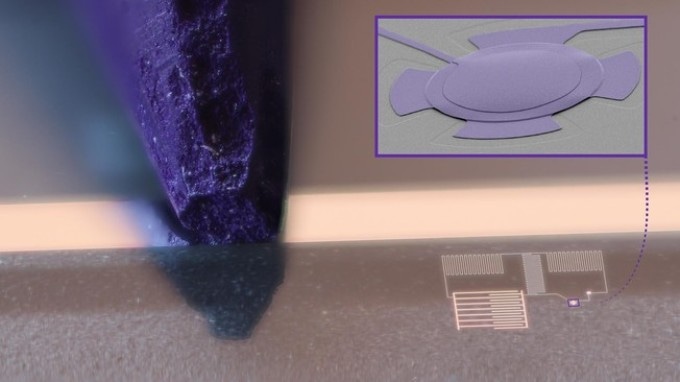May 16 2017
 Photograph of the chip used in the experiment to couple a microwave cavity to a micrometer-size drum (the sharp purple pencil tip is placed as a scale). Inset shows a scanning electron micrograph of the drum. The top membrane of the drum is suspended only 50nm (1/2000th of the diameter of hair) above a metal plate. This is then used to manipulate and amplify microwaves in the quantum regime. Credit: N. R. Bernier and L. D. Toth (EPFL).
Photograph of the chip used in the experiment to couple a microwave cavity to a micrometer-size drum (the sharp purple pencil tip is placed as a scale). Inset shows a scanning electron micrograph of the drum. The top membrane of the drum is suspended only 50nm (1/2000th of the diameter of hair) above a metal plate. This is then used to manipulate and amplify microwaves in the quantum regime. Credit: N. R. Bernier and L. D. Toth (EPFL).
Recently, EPFL researchers used a mechanical micrometer-size drum cooled close to the quantum ground state in order to amplify microwaves in a superconducting circuit.
A microwave resonator is a circuit that helps support electric signals oscillating at a resonance frequency. These researchers, in a recent experiment at EPFL, coupled the microwave resonator to the vibrations of a metallic micro-drum. Quantum mechanics allowed the active cooling of the mechanical motion close to the lowest energy, leading to the micro-drum turning into a quantum reservoir, here referring to an environment capable of shaping the states of the microwaves. The findings have been published as an advanced publication in Nature Physics.
László Dániel Tóth, Nathan Bernier, and Dr Alexey Feofanov headed the research effort in Tobias Kippenberg’s Laboratory of Photonics and Quantum Measurements at EPFL, with support from Dr Andreas Nunnenkamp, a theorist at the University of Cambridge, UK.
Just like visible light, microwaves are electromagnetic waves but with a frequency that is four orders of magnitude smaller. Microwaves are considered to be the backbone of several technologies used every day. These technologies range from cellular phones and microwave ovens to satellite communication, and they have recently gained immense importance in manipulating quantum information in superconducting circuits — one of the extremely promising candidates that realize quantum computers to be developed in the future.
The micro-drum, fabricated in the Center of MicroNanotechnology (CMi) at EPFL, is only 100 nanometers thick and 30 microns in diameter, and is made up of a capacitor in a superconducting microwave resonator. The position of the drum modulates the resonance frequency of the resonator and, conversely, a voltage across the capacitor applies a force on the micro-drum. This bidirectional interaction allows the exchange of energy between mechanical vibrations and the microwave oscillations in the superconducting circuit.
The experiment starts by first cooling the micro-drum close to its lowest energy quantum level by a suitably tuned microwave tone. The energy of a phonon (a quantum of mechanical motion) is carried away by every microwave photon (a quantum of light) in order to reduce the mechanical energy. This cooling process brings about an increase in the dissipation and also transforms the micro-drum into a dissipative reservoir for the microwave resonator.
It is possible to turn the cavity into a microwave amplifier by tuning the interactions between the cavity and the cooled micro-drum, which is currently an environment for the microwaves. The added noise, referring to how much unwanted, random fluctuations are added to the amplified signal, is considered to be the most interesting aspect of this amplification process.
Quantum mechanics, even though counter-intuitive, dictates that it is not possible to completely suppress this added noise, even in principle. The amplifier realized in the EPFL experiment works extremely close to this limit, thus it is as “quiet” as it can be. Interestingly, the micro-drum turns the microwave resonator into a maser (or microwave laser) in a different regime.
There has been a lot of research focus on bringing mechanical oscillators into the quantum regime in the past few years. However, our experiment is one of the first which actually shows and harnesses their capabilities for future quantum technologies.
Dr. Alexey Feofanov, Postdoctoral Researcher, EPFL
Going forward, this experiment enables novel phenomena in cavity optomechanical systems like noiseless microwave entanglement or microwave routing. The experiment basically proves that mechanical oscillators can indeed become a useful resource in the immensely growing field of quantum science and engineering.
Two recently launched EC Horizon 2020 projects, Hybrid Optomechanical Technologies (HOT) and Optomechanical Technologies (OMT), both coordinated at EPFL, will support future activities on the emerging research possibilities developed by this work
The Swiss National Science Foundation, NCCR QSIT, and the European Union iQUOEMS funded the project. L. D. Tóth was supported by the European Union’s Marie Curie International Training Network cQOM. A. Nunnenkamp holds a University Research Fellowship from the Royal Society and also acknowledges support from the Winton Programme for the Physics of Sustainability.